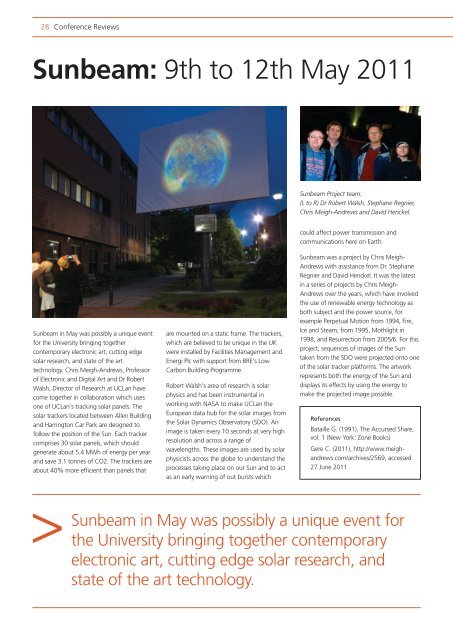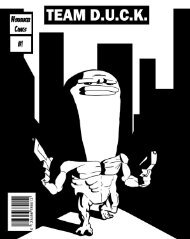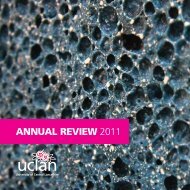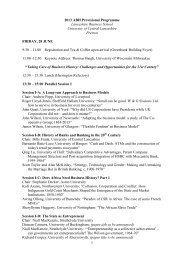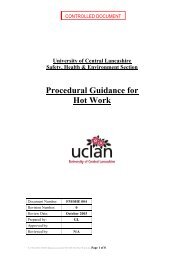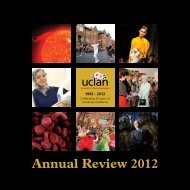Autumn 2011 Issue - University of Central Lancashire
Autumn 2011 Issue - University of Central Lancashire
Autumn 2011 Issue - University of Central Lancashire
Create successful ePaper yourself
Turn your PDF publications into a flip-book with our unique Google optimized e-Paper software.
28 Conference Reviews<br />
Sunbeam: 9th to 12th May <strong>2011</strong><br />
Sunbeam Project team:<br />
(L to R) Dr Robert Walsh, Stephane Regnier,<br />
Chris Meigh-Andrews and David Henckel.<br />
could affect power transmission and<br />
communications here on Earth.<br />
Sunbeam in May was possibly a unique event<br />
for the <strong>University</strong> bringing together<br />
contemporary electronic art, cutting edge<br />
solar research, and state <strong>of</strong> the art<br />
technology. Chris Meigh-Andrews, Pr<strong>of</strong>essor<br />
<strong>of</strong> Electronic and Digital Art and Dr Robert<br />
Walsh, Director <strong>of</strong> Research at UCLan have<br />
come together in collaboration which uses<br />
one <strong>of</strong> UCLan’s tracking solar panels. The<br />
solar trackers located between Allen Building<br />
and Harrington Car Park are designed to<br />
follow the position <strong>of</strong> the Sun. Each tracker<br />
comprises 30 solar panels, which should<br />
generate about 5.4 MWh <strong>of</strong> energy per year<br />
and save 3.1 tonnes <strong>of</strong> CO2. The trackers are<br />
about 40% more efficient than panels that<br />
are mounted on a static frame. The trackers,<br />
which are believed to be unique in the UK<br />
were installed by Facilities Management and<br />
Energi Plc with support from BRE’s Low<br />
Carbon Building Programme.<br />
Robert Walsh’s area <strong>of</strong> research is solar<br />
physics and has been instrumental in<br />
working with NASA to make UCLan the<br />
European data hub for the solar images from<br />
the Solar Dynamics Observatory (SDO). An<br />
image is taken every 10 seconds at very high<br />
resolution and across a range <strong>of</strong><br />
wavelengths. These images are used by solar<br />
physicists across the globe to understand the<br />
processes taking place on our Sun and to act<br />
as an early warning <strong>of</strong> out bursts which<br />
Sunbeam was a project by Chris Meigh-<br />
Andrews with assistance from Dr. Stephane<br />
Regnier and David Henckel. It was the latest<br />
in a series <strong>of</strong> projects by Chris Meigh-<br />
Andrews over the years, which have involved<br />
the use <strong>of</strong> renewable energy technology as<br />
both subject and the power source, for<br />
example Perpetual Motion from 1994, Fire,<br />
Ice and Steam, from 1995, Mothlight in<br />
1998, and Resurrection from 2005/6. For this<br />
project, sequences <strong>of</strong> images <strong>of</strong> the Sun<br />
taken from the SDO were projected onto one<br />
<strong>of</strong> the solar tracker platforms. The artwork<br />
represents both the energy <strong>of</strong> the Sun and<br />
displays its effects by using the energy to<br />
make the projected image possible.<br />
References<br />
Bataille G. (1991), The Accursed Share,<br />
vol. 1 (New York: Zone Books)<br />
Gere C. (<strong>2011</strong>), http://www.meighandrews.com/archives/2569,<br />
accessed<br />
27 June <strong>2011</strong><br />
><br />
Sunbeam in May was possibly a unique event for<br />
the <strong>University</strong> bringing together contemporary<br />
electronic art, cutting edge solar research, and<br />
state <strong>of</strong> the art technology.


